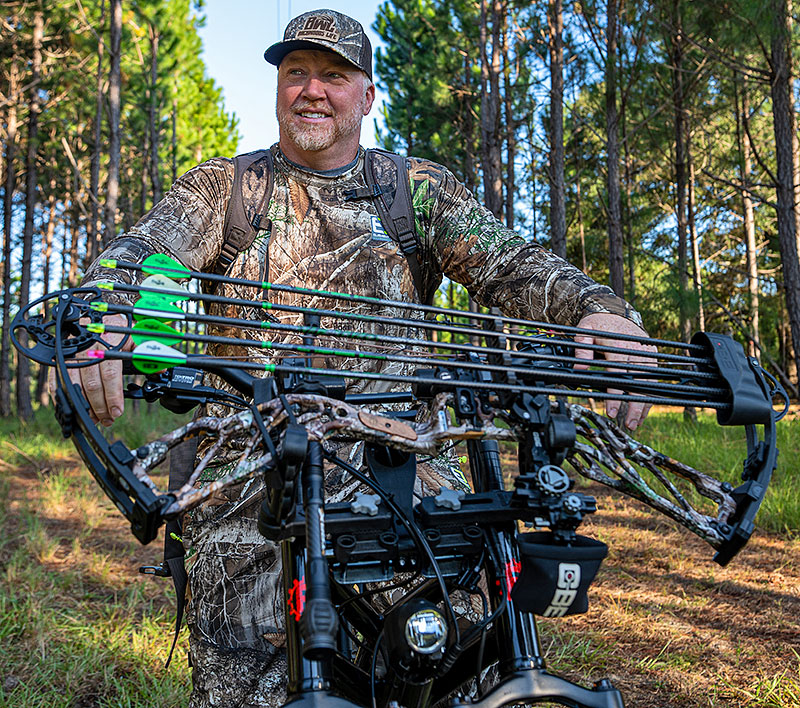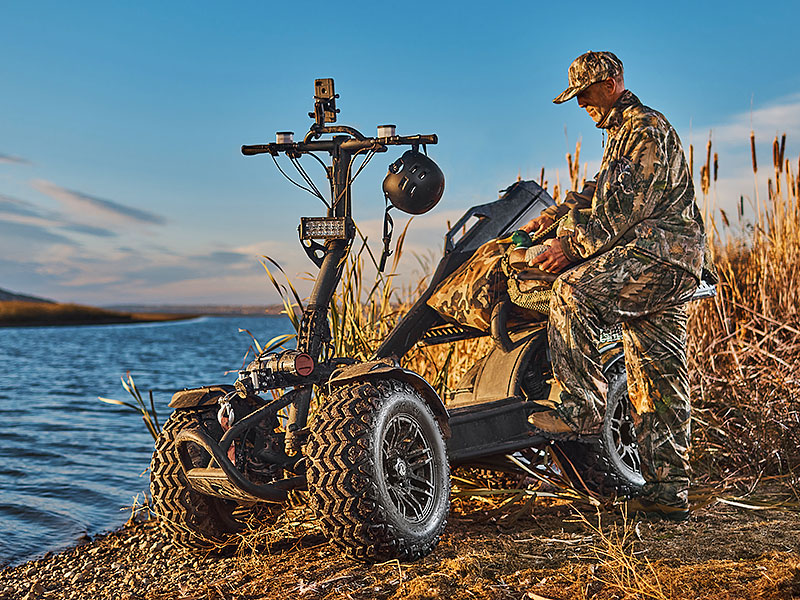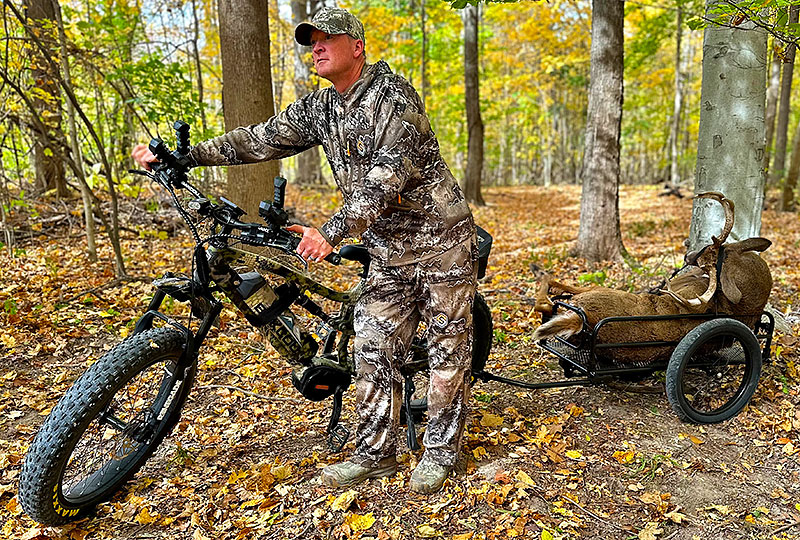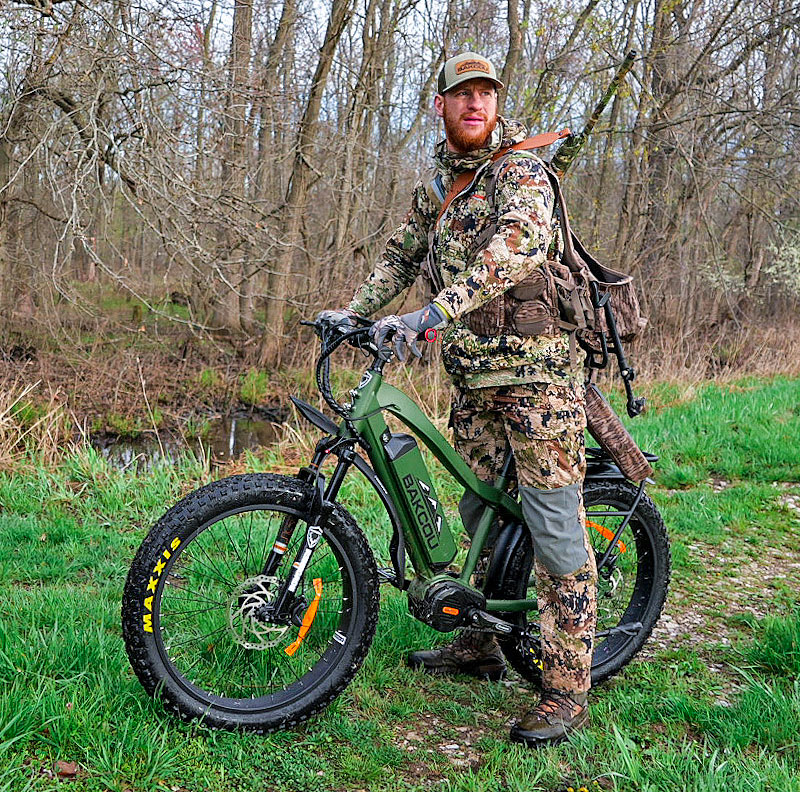
Sneaky and lightweight, electric hunting bikes find their way south
The first time I walked by a row of big-wheeled camo electric hunting bikes in a local sporting goods store, I shook my head and thought, “What will they come up with next?”
A month later, I walked by another rack of the newest craze in hunting wheels and actually pictured myself on one, sliding off the top of a rice levee or trekking through a big gumbo mudhole in the hardwood bottoms heading for my deer stand. When I saw the price tags — between $3,000 and $7,000 — I just shook my head again.
I must admit a personal bias against any type of electric vehicles other than golf carts. And I’m not exactly built to ride a bike anymore.
But recently, I saw a video of hunters using one of these big-wheeled bikes in the woods. Then I saw photos of another hunter hauling a deer on a cart out of the woods behind a bike, and I realized these are for real. They are built for rugged terrain, powered by a powerful motor and light-weight frame that can tote a 300-pound rider and still pull a small trailer behind them.
A quiet getaway
These bikes are perfect for the solitary hunter who wants to get far away from the crowd, go in tight places, and not raise a ruckus getting there. The convenience of fewer moving parts than traditional woods transportation also help sell the “bike, don’t hike” story.
Electric hunting bikes are bikes on steroids — with sturdy frames, heavy duty suspensions and fat tires for stability in varied terrain. Electric hunting bikes started mostly out west where hunters and outdoor explorers were going off road in pretty rugged terrain, but they also have applications in hunting habitat like we have here in Louisiana and around the south.
There are dozens of options and the electric hunting bike industry is still making strides every year. If you are looking for an eBike for hunting, some of the highest rated and best selling are listed below:
- The Mule Elite, Storm and Kodiak by Bakcou
- The Rebel 1000W Truetimber, Nomad and Bushwacker by Rambo
- Megatron X2wd Electric Hunting Bike By Rambo Bikes
- Apex, Jeep and Ranger Powered By Quietkat
- RadRover 6 by Power Bikes Rad Power
- The Dualie and Dualie XR Rubicon Trail Edition by Rungu

For hunters, by hunters
Justin Schroepfer, vice president – marketing for Bakcou, a Utah company and one of the top manufacturers of electric hunting bikes, explained a little bit about the history of the vehicles and what customers need to look for in choosing an eBike.
“Dave Andre and Bryan Child are brothers-in-law who are also hunters and wanted to venture into something that would enhance their hunting experiences,” Schroepfer said. “As they considered different opportunities, they came up with the idea of building eBikes for hunters, by hunters. That’s how we got our start.”
It’s definitely a fairly new trend, yet based on one of the oldest methods of transportation since the invention of the wheel.
“One of the biggest advantages of an eBike is stealth,” Schroepfer said. “If you want to increase your chances of a successful hunt, being as quiet as possible is obvious. These bikes allow for stealth and help avoid disturbing wildlife.”
Another big advantage is maneuverability. If you’ve ever tried to turn around an extended side-by-side in the thick woods, you understand.
“There are just some places and trails where a larger vehicle can’t go,” he said. “These bikes enable hunters to go deeper into the backcountry and reach those hard to get to areas. We’ve actually seen hunters attach their eBikes to their side-by-sides and when they get as far as they can with them, they stop and continue on the bike.”
How about the mud?
Hardwood bottoms with gumbo mud, slick rice field levees and general swampy conditions might sound like a no-go for eBikes and while they offer a challenge, it isn’t a deal breaker. Several eBike models are made for these conditions as long as they are not extreme.
“We know that muddy situations can’t be avoided and wanted to develop an eBike that could conquer any terrain,” Schroepfer said. “Our Kodiak is an all-wheel beast that features a hub drive motor on both the rear and front tires. This allows the rider to toggle between front wheel drive, rear wheel drive or both, depending on conditions.”
Even with a specially equipped bike, these vehicles won’t take on extreme mud or water that even challenge four-wheelers or side-by-sides, but with more ease getting off the established trails, many times those spots can be avoided.
Louisiana is an emerging market for eBikes. States like Texas, Arkansas, Florida and Georgia are also growing in sales every day.

Quieter than walking
Michael Mayer, the Marketing Director at QuietKat, a Colorado company, said there’s a growing contingency of hunters that now consider their eBike a critical piece of gear. Ask them why and they’ll all tell you the big benefit all due to one game-changing thing: access.
“A pedal assist bike can get you deep into your favorite remote hunting grounds easier than your truck and your four wheeler,” Mayer said. “Shaving hundreds of pounds off your access rig unlocks incredible opportunities for ease of scouting, placing game cams, and even finding a new sweeping viewpoint.
“True, we’ve all ripped around a corner in a four wheeler and surprised an unsuspecting deer. But imagine what hears that four stroke engine coming from a mile away and is long gone by the time you approach. A high quality electric hunting bike is the perfect mix of power and stealth and could completely boost the success of a scouting mission or get you to your duck blind or tree stand without spooking nearby game. In some cases, a pedal assist hunting bike can even be quieter than walking.”
Mayer also adds that while an electric hunting bike is not without scent (chain lube and cleaner, tube sealant, and more minor detectable smells), compared to gas, oil, transmission fluid and exhaust, the scent profile is dramatically reduced.
Investing in an eBike is no small thing. When considering which eBike to choose, it’s important to do your homework. A multitude of YouTube videos and instructional material, plus information on the various companies offering eBikes, is readily available on the internet.

There are two critical components of an eBike potential buyers must learn about and compare; the motor and the battery. For hunters, you will want to make sure you have a durable, powerful motor that will ensure you can conquer any terrain. The battery is key. The bigger the battery, the more distance you can go, which is key. You want to make sure you can get out in the backcountry, but more importantly, you want to make sure you have enough “juice in the tank” to get you back.
Most eBike batteries come in either 36, 48 or 52 volt options. Simply put, the higher the voltage, the more acceleration and more torque your bike will provide. Amp hours are also important to be considered. Amp hours are most simply explained as being like a four-wheeler’s gas tank. The more hours, the more “gas” you’ve got.
Range for batteries depends on use. The more rough the terrain, the more weight the bike is carrying and even wind speed, tire pressure and the size of the motor all impact range.
Know the company
Another important factor to consider is the company. Do they have strong reviews? Do they have great customer service and stand behind their eBikes? There are so many eBikes coming into the market. It’s important to research the companies as much as you do the eBikes.
As with any major investment, the way you treat and maintain your electric hunting bike is the most important thing you have to consider once you’ve actually made a purchase.
Keeping the unit clean after use and making sure batteries are charged is of utmost importance. You never want to run the lithium batteries totally dead. Usually if they get to 10%, that’s as low as you want it to go. The good news is when batteries get low, you can reduce “pedal assist” and actually pedal the bike to extend your range.
Storage is important. If you keep the bike stored for a long period, it is best to keep batteries charged at a rate recommended by the maker. In the summer, you need to keep it cool and let the battery “breathe.” In the winter, it’s important to keep the battery warm when you can, even if you have to wrap it in something in extreme conditions.
Before riding, quick safety checks are as simple as A, B, C. Air is for air pressure. Make sure your tires are at the optimal pressure for your conditions. B is for brakes. Make sure they are working well. You can check them by just giving them a squeeze. If they are firm, it’s all good. If they are spongy and don’t engage, its probably time to bleed the brakes or get them checked on. And C is for the chain. Make sure it is not rusty and it is fitting firmly on the gears. Also check the chain while riding by watching it as you shift, making sure it is in good contact.

Are two better than one?
If one is good, two must be better. That’s the thought behind the Rungu Dualie with its two-front-tired bike. And how about a standup model, like the fairly new LyteHorse?
“We came up with the Rungu Dualie concept to be able to ride on and with an eye toward military use,” said Peter Dolewski, President of the California-based company. “But the Dualie handles rocks and mud equally well.
“Rungu Dualie has quad ATV performance without the noise, scent trail, path width and weight, and it avoids spooking deer or turkey on the way to your stand. The bike will fit between trees and ride over terrain beyond the scope of a quad.”
A new vehicle designed by a Canadian company carries the options for hunting one step further. LyteHorse has put a stand-up electric all-terrain vehicle on the market. Originally, designed for law enforcement and security purposes, it is growing in popularity among outdoorsmen.
LyteHorse said one of the critical differences between its product and a traditional quad is the machine’s stability. Most riders have no learning curve, which means easy riding, and the wheels are offset which helps make it very stable. According to their data, not only does the LyteHorse have no drivetrain, no gas or oil, nothing to lubricate or change out, and zero sound emissions, it also has a tipping point of 67 degrees, compared to a typical quad, which is about 37 degrees.
The right choice
If this is something that interests you, only one person can make the right choice for you. And that’s you. In gathering information from dealers and manufacturers, there are some things that you should consider. Of course, price is a good starting point. But as in everything, you get what you pay for is usually a good thing to remember.

